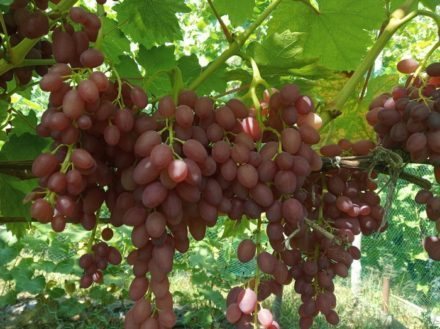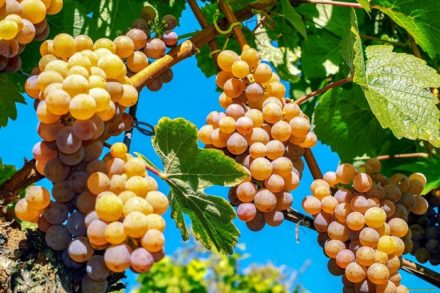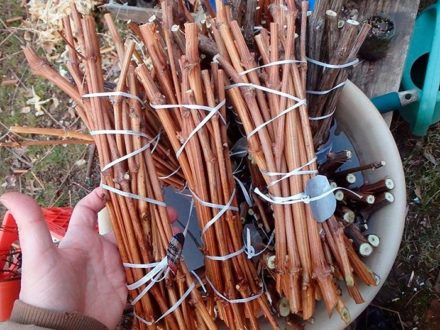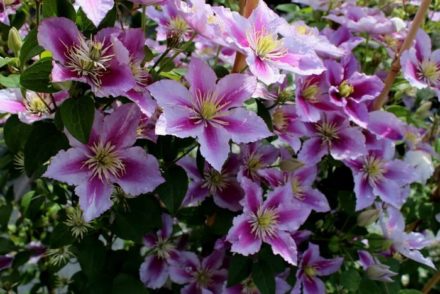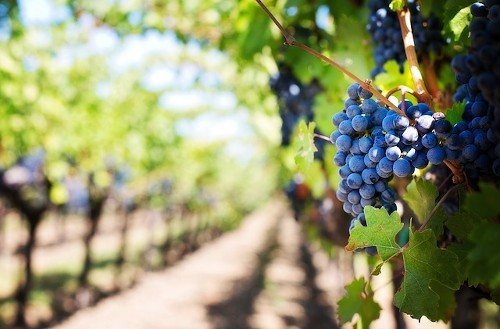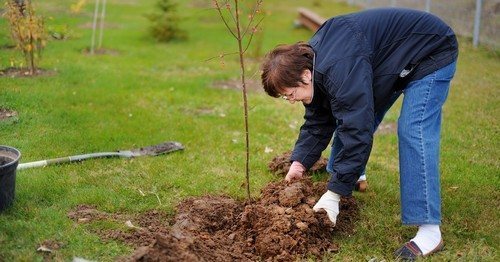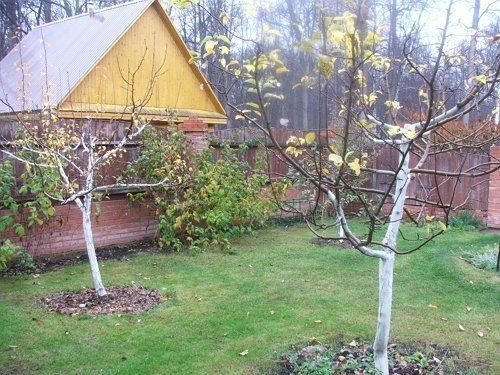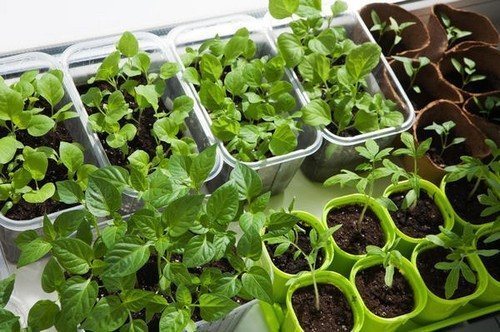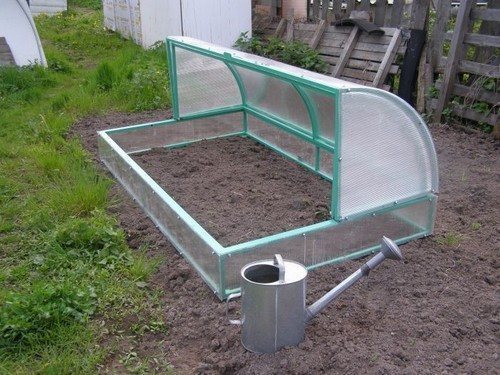Pruning grapes is a vital part of proper bush development. It is necessary to control the formation of the trunk and obtain a high-quality harvest of berries. Bushes need to be pruned annually according to a certain pattern. Fruits are obtained only from one-year-old shoots. Thus, healthy new shoots must be produced each year to maintain good berry production.
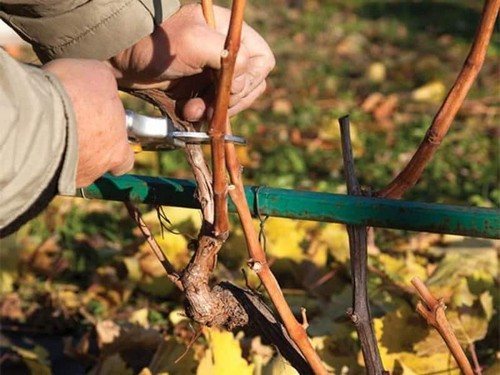
- Why prune grapes in the fall
- When to prune grapes
- Depending on the variety
- Depending on the region
- According to the lunar calendar
- Preparation for pruning
- Preparing the bush
- Tool
- How to prune grapes
- General rules and pruning scheme
- One-year bush
- Two-year bush
- Three-year bush
- 4, 5 years and older
- Neglected bush
- Care after pruning
- Processing cuts
- Shelter for the winter
- Tips for beginners
Pruning grapes during the dormant period in the fall is necessary to ensure proper support. This allows you to select fruit shoots and manipulate the potential number of berries produced. Correct formation of the plant helps to increase sugar content and enhance the taste characteristics, and also brings the ripening time closer.
Why prune grapes in the fall
Pruning of grape vines is carried out in the period between the fall of leaves in the fall and the first cold weather. Harvesting is stressful for the plant, the bushes need to rest for a couple of weeks so as not to subject them to double stress. If the leaves do not fall naturally, do it manually.However, if there is time left before frost, it is better to wait. Dying leaves transfer all the nutrients to the stem and roots, and only then fly off themselves.
In spring, the bush is formed for the summer before sap flow. All dried and frostbitten branches during the winter are cut out, and the plant is placed on poles or other supports. This procedure is practical in regions with not very cold winters, because covering unpruned grapes will not work.
There is a practice of “double pruning”. Sometimes it is used to avoid injury from spring frosts. In winter, the branches are pruned superficially, and then, in the spring, as soon as a bud appears, the procedure is repeated while maintaining the optimal number of buds. This effectively delays bud break at the base for several days.
Autumn pruning of grapes has a more gentle effect on the plant, because it is already in a dormant period. In the spring, if you make a slight mistake with the timing, you can provoke “crying of the vine.”
The buds will bloom faster and flowering will begin early if the correct pruning is done. It does not slow down the ripening of fruits and does not reduce the vigor of shoot growth. When pruned in spring, fruiting occurs later because the bush is exhausted from crying. Pruning in autumn is suitable for regions with covered cultivation of grapes. This makes it easier to care for the bush until spring.
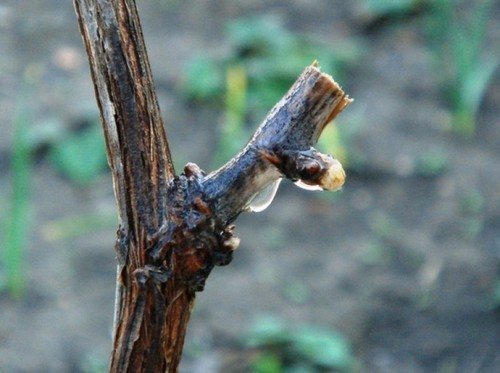
When to prune grapes
Experienced winegrowers thin out the bushes if necessary in summer, spring and autumn. The main autumn (formative) pruning is performed in mid-late October.
To determine the date, you need to take into account the climate and terrain, soil characteristics, processing methods, weather conditions and the variety of technical or table grapes.The optimal calculation is 20 days after leaf fall.
Early fall pruning may increase the vine's susceptibility to frost injury compared to later pruning. In regions where there is a significant risk of cold snaps, it is prudent to delay the timing until the coldest temperatures in winter.
Depending on the variety
Early ripening varieties are pruned a little earlier than late ones. This is logical, because the countdown begins after the harvest. The difference is approximately 3-5 weeks. Hybrids are pruned in the fall according to the same principle - 3-4 weeks after the leaves have completely fallen off. Grape varieties are divided into frost-resistant and heat-loving. It is better to postpone pruning the latter until spring.
Depending on the region
In the regions of Central Russia, it is worth hurrying up with spring pruning, in time before the sap begins to flow. But there is no need to rush with autumn pruning of grapes.
In the Far East, North and Siberia, on the contrary, it is better not to postpone the procedure for long. It is prudent to do double pruning here. The first - 3 weeks after harvest (second half of September). The second - immediately after the first frost, before snow falls (late September - first ten days of October).
In areas of uncovered viticulture and in warm climate zones, the main time for pruning vines is from late September to early November.
| Central Russia | End of October - beginning of November. |
| Crimea | South - November, northern regions - October. |
| Moscow and Moscow region | Second half of October - beginning of November. |
| Kuban | September October. |
| Ural | Late October - early November (before the onset of cold weather). |
| Siberia | Late August to mid September. |
| Ukraine | Mid November. |
| Belarus | September October. |
According to the lunar calendar
It is believed that the lunar calendar influences all biological processes not only of grapes, but of all plants. The waxing moon raises the juices to the upper part, so you should not carry out the procedure during this period. The exception is young grape bushes.
Plant juices go into the roots during the waning moon. In this regard, pruning is carried out during this period, immediately after the full moon.
Some winegrowers synchronize all manipulations with the plant according to the lunar calendar. But don't blindly rely on it. Data collected by scientists over many years provide more valuable information on the timing of various procedures for caring for fruit and berry crops.
Preparation for pruning
You shouldn't rush right into the quarry. Before pruning, you need to prepare. Walking around the vineyard will allow you to examine all the bushes, find pests, and identify diseased plants. Instruments are sharpened in advance and immediately before the procedure are disinfected (with alcohol, copper sulfate, chlorhexidine)
Preparation of the bush
The main procedure for forming a grape bush does not begin immediately, but after careful preliminary work. Foliage and dried bunches are removed, excess roots on the surface and growths are cut out.
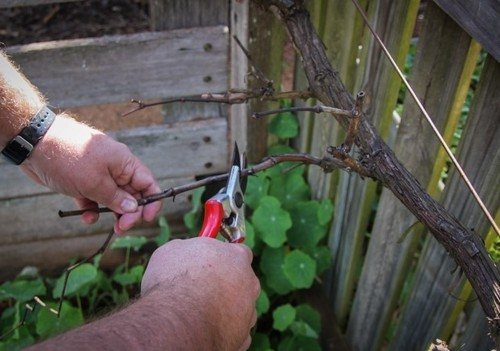
Tool
Tools required for pruning grapes:
- pruner;
- saws;
- lopper
A pruner is a basic tool that is easy to use. It is suitable for primary pruning and for removing thin branches of young vines. It is easier to operate if it is equipped with two stainless steel blades.
If the plant is mature and the thickness of the vine has already reached 8 cm, you will have to use saws or hacksaws.
A lopper is a type of pruner, differing in the length of the handle and the size of the blades. It allows you to remove branches up to 5 cm in hard-to-reach places.
How to trim grapes

Although there are several ways to prune a grapevine. Each has its own characteristics, but all have the same basic steps for caring for varieties that require protection from winter cold. These grape varieties must be formed into one or more horizontal trunks. Old, dried branches of the vine are removed in stages, with the exception of new fruit-bearing branches and buds. A strong branch is selected and docked at about 1 meter, leaving a small shoot with two buds. This branch should be tied to a wire support or trellis. All other branches are deleted.
General rules and pruning scheme
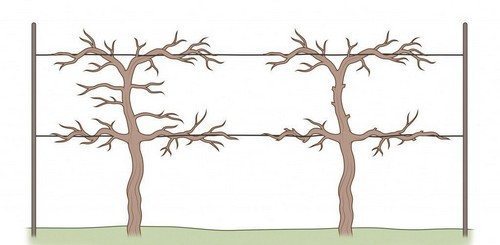
(Four-arm formation using the Kniffen method)
The easiest way to prune grape varieties that do not require winter protection is to use the Kniffen four-arm method. This method involves using two horizontal wires to support the vine rather than just one. The bottom one is usually about 90-100 cm from the ground, and the other about 150 cm. As the vine grows, it is pulled over the wire, all shoots between the two wires are removed along the underside of the vine to two buds. Mature vines will have four to six branches, each of which may have 5 to 10 buds, and four to six restorative nodes.
As a rule, only buds with clearly defined internodes in both directions are counted when counting buds.Basal buds are not counted because they often do not produce shoots, and if they do produce shoots, they are often sterile.
The winegrower often prunes grapevines to achieve a balance between berry production and adequate, but not excessive, shoot growth. Increasing the number of buds increases the number of shoots, and excess leads to increased shading.
Annual bush
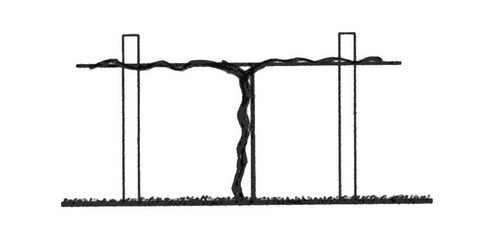
In the first year of the growing season, all fruits and unwanted side shoots are removed from the vine. The vine tends to grow rapidly from its main growing point once the side shoots and fruits are removed. A one-year-old grape bush should be laid on a support (twine or rope) so that the new sleeve forms a straight trunk. The leaves must remain on the developing trunk to produce the necessary carbohydrates to feed the plant; all side shoots, however, must be removed.
A young bush sometimes reaches the top rope (150 cm) in a year. If this happens, cut off the end of the shoot at the top wire and then the side shoots will grow horizontally in both directions lengthwise. They will be used to form new cordons. Pruning of annual hardwoods will be minimal, but some pruning may be required to help shape the vine before the second year of growth begins.
Two-year-old bush
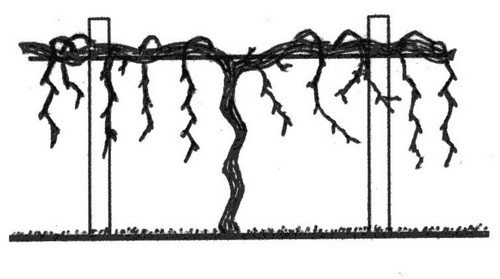
In the second year, it is worth removing all the berries and any side shoots that have appeared along the trunk. If the vines have not completed their structural development in the first year, form the correct growth of new shoots so that the sleeves completely occupy the intended area of horizontal support.
Once the lateral shoots have grown along the top wire to the desired location, trim the ends of the main lateral shoots (on the top wire). This will force secondary shoots to develop along the two main lateral sides. The remaining fruiting wood should have a pencil diameter. Renewal of spurs produces vegetative shoots, which are used for fruiting the following year.
Three-year bush
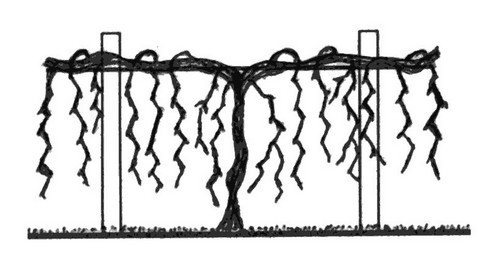
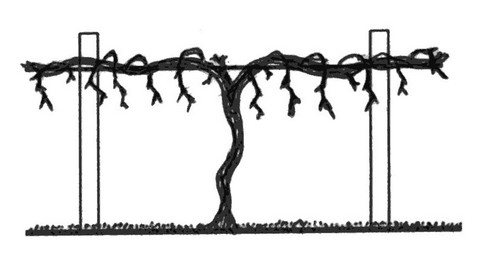

The third year is the first year of fruiting of the bush. One-year wood should be cut back to three-, four- or five-node branches. The vine should be evenly distributed along the support and directed downwards.
In this case, 2-3 vines are left on each of the sleeves. The total number of buds should be no more than 50. On thin trunks, the number should be reduced.
4, 5 years and older
The perennial bush is already a strong, mature, fruit-bearing plant. Shoots, foliage, and dried vines are removed from it. Small and weak shoots are determined by their diameter (little finger-sized); they have signs of cracking and are weakly attached to the trunk.
All branches older than 2 years, non-fruit-bearing stems. Cuts are made at an angle of 45 degrees to protect from rain.
It is practical to select two to four of the newest fruit-bearing branches from each vine and mark them with bright fluorescent tape. The largest, thickest branches with only a few shoots are marked in order to remove them first, preserving the thinnest branches with the most buds.

It is necessary to cut off all unproductive shoots and shoots with less than 14 buds, taking into account the uniform distribution throughout the bush.
Neglected bushOnce the side shoots have grown along the top wire to the desired location, dock the ends of the main side shoots (on the top wire). This will cause secondary shoots to develop along the two main sides. The remaining fruit wood should be the diameter of a pencil. Renewal of spurs produces vegetative shoots that are used for next year's fruiting.
Three-year-old bush
The third year is the first year of fruiting of the bush. One-year-old wood should be pruned back to three-, four-, or five-node branches. The vine should be evenly spaced along the support and point downwards.
Cruciferous flea beetle in the garden: 4 safe ways to control the pest
In this case, 2-3 vines are left on each of the sleeves. The total number of buds should be no more than 50. On thin trunks the number should be reduced.
4, 5 years and older
All branches are older than 2 years, non-fruiting stems. The cuts are made at a 45 degree angle to protect from rain.
It is practical to select two to four newest fruiting branches from each vine and mark them with bright fluorescent tape. The largest, thickest branches that have only a few shoots are marked so that they are removed first, preserving the thinnest branches that have the most buds.
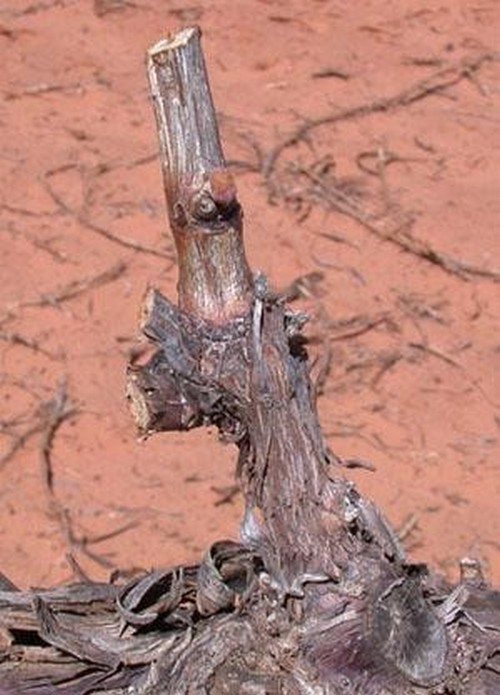
It is necessary to cut off all unproductive shoots and shoots with less than 14 buds, taking into account an even distribution throughout the bush.
neglected bush
- Grape growers complain about neglected cases in which annual branches are intertwined along supports and wires. They are extremely difficult to unwind for cutting. It's a lot like combing your hair.
- Once the green shoots are sufficiently developed (around mid-July), each shoot can be placed in an orderly position parallel to the vertical trunk. Combing or positioning the shoots can help reduce the overall number of tangled shoots and increase light penetration into the vine canopy. Increased exposure to sunlight improves fruit quality, winter hardiness and next year's yield.
- Care after pruning
- After properly performed autumn pruning until spring, the vineyard does not require special care. But it is important to process each cut, otherwise the entire plant may die. And also properly cover it for the winter before frost sets in.
- Processing slices
The most important thing after the procedure for autumn pruning of grapes is to treat the cuts from pests, dampness and infections. There are many special chemicals, gels, and pastes for this. A traditional effective method is treatment with a hot 5-7% solution of copper sulfate. And only after this can you begin to carefully cover it for the winter.


